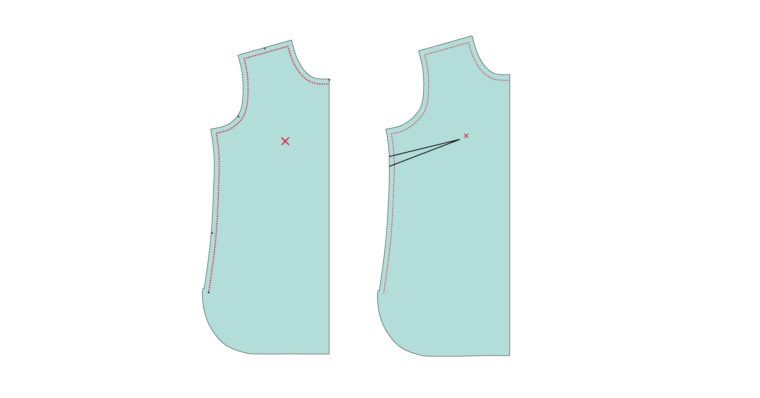If your bust is larger than a B cup, you might want to make the following simple adjustments to some patterns to add a bust dart in order to help get a better fit. For this example, I’m using our Gallery Tunic and Dress, but these instructions can be applied to many patterns without a dart. For example, if you feel like you need a dart to the Chaval Coat you could easily add one using these steps.
1. Draw in the 1/2” seam lines on the front pattern piece. Then hold up the pattern piece to your body, matching the center front and shoulder seam, and mark the apex on your pattern piece. The apex is the fullest part of your bust. (Be sure to wear a well-fitting bra when you do this!)
2. Next you’ll draw three lines on the pattern piece. Line #1 begins at the apex and extends to the hem, staying parallel to the center-front line. Line #2 begins at the apex and extends approximately one-third of the way up the armhole, as shown in the illustration below. Line #3 begins at the apex and extends to the side seam at the location where you’d like to position the bust dart. (In general, most bust darts angle down an inch or more below the level of the apex.)
3. Cut the pattern piece along line #1, starting at the bottom edge, and pivot to continue cutting through line #2, leaving a small paper hinge just at the seam line of the armhole. (Not at the cutting edge, but at the seam line itself, which you’ll need to draw into your pattern piece.) Make a second cut along line #3 starting at the side seam, this time leaving a paper hinge at the apex. (See the circles in the illustration below for the location of the hinges, and refer to the illustration in Step 4 for further clarification of the hinge locations.)
4. Spread the pattern piece along line #1, keeping the cut edges parallel to each other while allowing the rest of the pattern piece to lie flat as you spread it. For a C cup, spread line #1 by 1/2”. For a D cup, spread line #1 by 3/4”. As you spread the cut at line #1, lines #2 and #3 will open more and a bust dart will form at line #3. The amount of extra space you add will taper to nothing at the paper hinges, so the length of the armhole at the seam line won’t change. The combination of adding extra width at the chest and creating a larger dart will allow extra room at the bust without significantly altering the rest of the pattern. Tape tissue or plain paper behind the cuts to fill the gaps produced by the spreading. (Note that the bottom edge of the pattern will no longer match up at this point, but you’ll correct it in the next step.)
5. Draw the bust dart starting at the cut edges of line #3, at the side seams, and ending approximately 1” from the original position of the marked apex. (This distance will vary from person to person and also depends on how fitted the garment is. Most garments that don’t include a bust dart won’t be too fitted, so you’re probably safe assuming 1″ from the apex. Do a test fit, or muslin, to confirm the dart before you cut into your actual fabric!) Tape tissue or plain paper to add length to the center-front bottom edge, to match the lengthened hem. This extra length doesn’t alter the length of the garment itself; it’s only allowing extra fabric over the bust, so you don’t need to change the length of the back pattern piece or anything else.
This added dart will help you to get a better fit, and further adjustments can be made as needed when you do a fitting. From here you can stitch the dart and proceed with the sewing instructions as usual.
That wasn’t so bad, was it?

